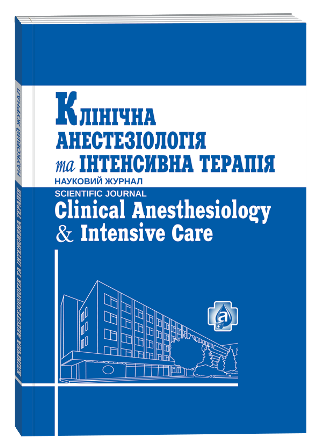SYSTEM OF HEMOSTASIS DURING OPERATIONS OF OSTEOSYNTHESIS IN PATIENTS WITH FRACTURES OF LONG TUBULAR BONES OF LOWER EXTREMITIES
Keywords:
hemostasis, prophylaxis of thrombotic disorders, spinal anaesthesiaAbstract
Background. Massive tissue trauma, prolonged surgical interventions, rheological disorders, significant blood loss, old age and other risk factors (including their combination) put trauma patients at high perioperative risk. Effect of surgery and anesthesia on the hemostatic system is very significant and requires careful anesthesiologist’s attention. Aim. To determinate possibilities of the functional status the system of hemostasis during operations of metallo-osteosynthesis in patients with fractures of long tubular bones of lower extremities. Materials and methods. We studied the system of hemostasis and fibrinolisys in 66 patients with fractures of long tubular bones of lower extremities before operations and after starting operation through 1–2 hours. Patients were divided into 2 groups depending on anaesthesia type: 1 group — 35 patients were performed spinal anaesyhesia, 2 group — 31 patients were performed general anaesthesia. Results. It was studied the effect of anaesthesiological providing on functional status of hemostasis during operations of metallo-osteosynthesis in patients with fractures of long tubular bones of lower extremities. The instrumental express-method of low-frequency piezoelectric hemoviscoelastography helps to screen system of hemostasis in different stages of operation, test prophylaxis of thromboembolical complications and hemorrhage, and, if necessary, treat patients in time. Conclusions. The usage of spinal anaesthesia prevents intraoperative thrombotic complications and the usage of general anaesthesia require additional measures for prevention of thrombotic complications.
References
Лазаренко Ю. В. Можливостi в оперативному лiкуваннi хворих з закритими переломами дистального вiддiлу стегнової кiстки / Ю. В. Лазаренко // Таврический медико-биологический вестник. – 2011 – Т. 14, № 4, ч. 1 (56). – С. 109–111.
Функциональное состояние компонентов гемостаза у больных с острой интраоперационной кровопотерей / В. Е. Шипаков, Е. Г. Рипп, М. Б. Цыренжапов [и др.] //Анестезиология и реаниматология. – Москва, 2009. – № 2. – С. 49–52.
Артерiальнi, венознi тромбози та тромбоемболiї. Профiлактика та лiкування. – К. : ЗАТ «Вiпол», 2006. – 72 с.
Дерябин И. И. Травматическая болезнь / И. И. Дерябин, О. С. Насонкин. – Л. : Медицина, 1987. – 301 с.
Кiрпiчнiкова К. А. Дiагностика, профiлактика та корекцiя стану тромбонебезпеки при ендопротезуваннi кульшового суглоба : автореф. дис. канд. мед. наук / К. А. Кiрпiчнiкова. – Днiпропетровськ, 2007.
Зильбер А. П. Клиническая физиология в анестезиологии и реаниматологии / А. П. Зильбер. – М. : Медицина, 1984. – 480 с.
Анестезиология : в 5-ти т. / под ред. В. И. Черния, Р. И. Новиковой. – К. : Здоров’я, 2004. – Т. 3. Интенсивная терапия при неотложных состояниях. – С. 135–149.
Морган-мл. Дж. Эдвард. Клиническая анестезиология / Дж. Эдвард Морган-мл., Мэгид С. Михаил. – М. : Бином, 2003.
Рафмелл Д. П. Регионарная анестезия: Самое необходимое в анестезиологии : пер. с англ. / Д. П. Рафмелл, Д. М. Нил, К. М. Вискоуми ; под общ. ред. А. П. Зильбера, В. В. Мальцева. – 2-е изд. – М. : МЕДпресс-информ, 2008. – 272 с.
Guidelines of hemostasis inhibiting drugs and neuraxial anaesthesia (Spanish) / J. V. Pitarch, J. De Ibanez, C. Sancho [et al.] // Rev Esp Anestesiol Reanim. – 2005. – Vol. 52. – P. 413–420.







